Financial Analysis: Kadlex Plc WACC and Investment Appraisal
VerifiedAdded on 2023/01/16
|16
|3896
|59
Report
AI Summary
This report delves into the financial management of Kadlex Plc, addressing key aspects such as Weighted Average Cost of Capital (WACC) calculations, both at book and market value, and analyzing the impact of proposed changes to the capital structure. The report explores the integration of gearing to minimize WACC and evaluates the effects of short-termism on bankruptcy and agency problems. Furthermore, it examines investment appraisal techniques, including Payback Period, Accounting Rate of Return (ARR), and Internal Rate of Return (IRR), to assess the economic feasibility of acquiring new machinery for Lovewell, a food manufacturing company. The analysis provides detailed calculations and critically evaluates the benefits and limitations of each investment appraisal method to support sound financial decision-making.

Financial
Management
Management
Paraphrase This Document
Need a fresh take? Get an instant paraphrase of this document with our AI Paraphraser
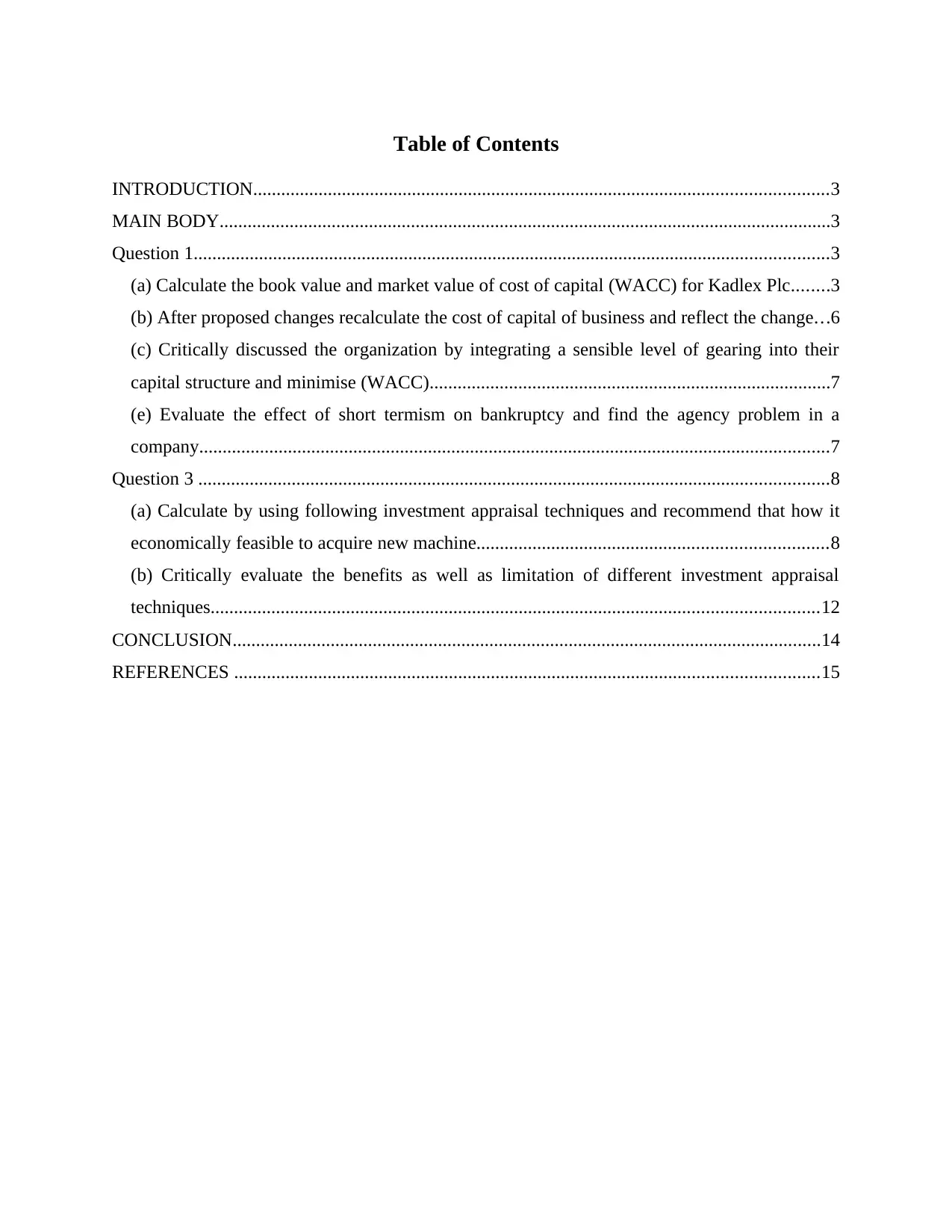
Table of Contents
INTRODUCTION...........................................................................................................................3
MAIN BODY...................................................................................................................................3
Question 1........................................................................................................................................3
(a) Calculate the book value and market value of cost of capital (WACC) for Kadlex Plc........3
(b) After proposed changes recalculate the cost of capital of business and reflect the change...6
(c) Critically discussed the organization by integrating a sensible level of gearing into their
capital structure and minimise (WACC)......................................................................................7
(e) Evaluate the effect of short termism on bankruptcy and find the agency problem in a
company.......................................................................................................................................7
Question 3 .......................................................................................................................................8
(a) Calculate by using following investment appraisal techniques and recommend that how it
economically feasible to acquire new machine...........................................................................8
(b) Critically evaluate the benefits as well as limitation of different investment appraisal
techniques..................................................................................................................................12
CONCLUSION..............................................................................................................................14
REFERENCES .............................................................................................................................15
INTRODUCTION...........................................................................................................................3
MAIN BODY...................................................................................................................................3
Question 1........................................................................................................................................3
(a) Calculate the book value and market value of cost of capital (WACC) for Kadlex Plc........3
(b) After proposed changes recalculate the cost of capital of business and reflect the change...6
(c) Critically discussed the organization by integrating a sensible level of gearing into their
capital structure and minimise (WACC)......................................................................................7
(e) Evaluate the effect of short termism on bankruptcy and find the agency problem in a
company.......................................................................................................................................7
Question 3 .......................................................................................................................................8
(a) Calculate by using following investment appraisal techniques and recommend that how it
economically feasible to acquire new machine...........................................................................8
(b) Critically evaluate the benefits as well as limitation of different investment appraisal
techniques..................................................................................................................................12
CONCLUSION..............................................................................................................................14
REFERENCES .............................................................................................................................15
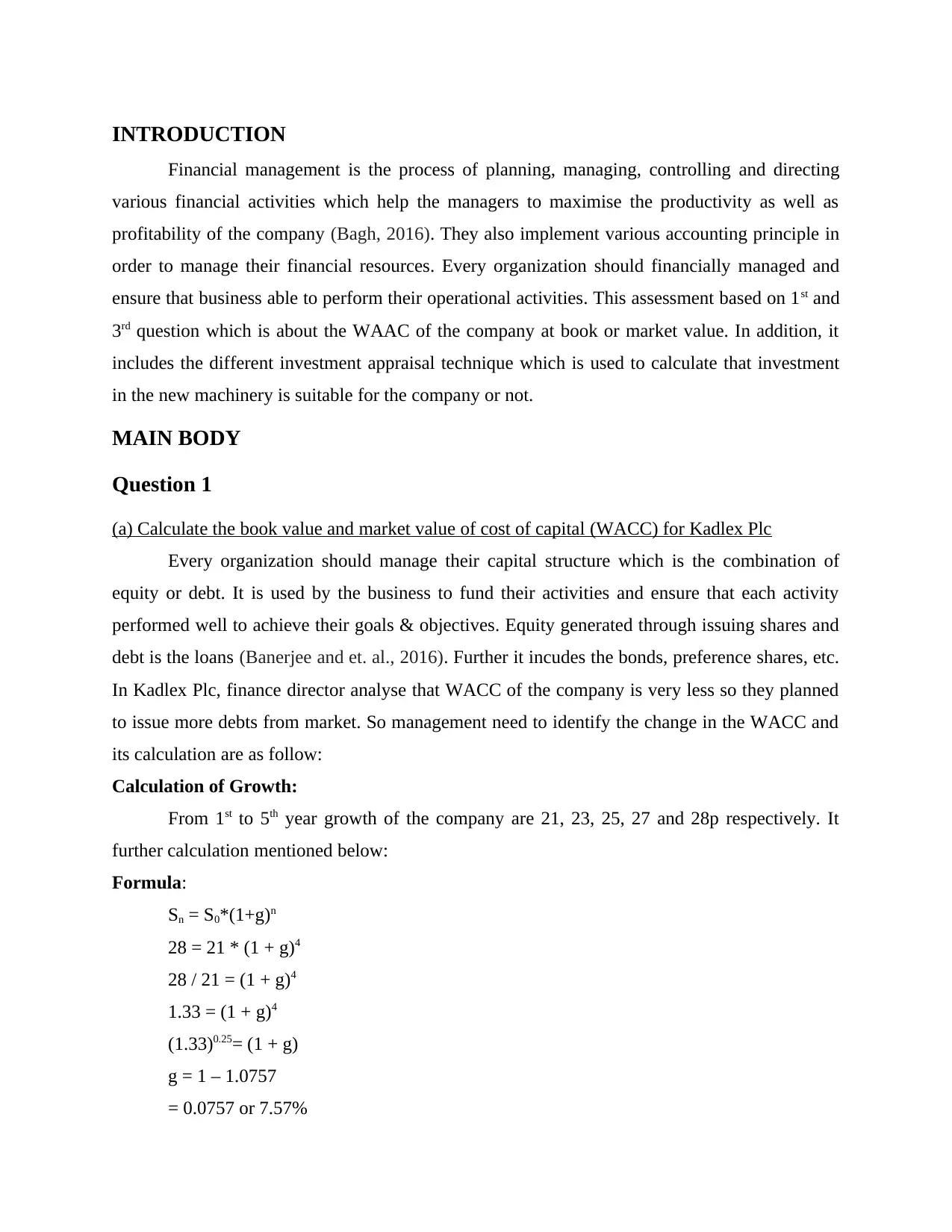
INTRODUCTION
Financial management is the process of planning, managing, controlling and directing
various financial activities which help the managers to maximise the productivity as well as
profitability of the company (Bagh, 2016). They also implement various accounting principle in
order to manage their financial resources. Every organization should financially managed and
ensure that business able to perform their operational activities. This assessment based on 1st and
3rd question which is about the WAAC of the company at book or market value. In addition, it
includes the different investment appraisal technique which is used to calculate that investment
in the new machinery is suitable for the company or not.
MAIN BODY
Question 1
(a) Calculate the book value and market value of cost of capital (WACC) for Kadlex Plc
Every organization should manage their capital structure which is the combination of
equity or debt. It is used by the business to fund their activities and ensure that each activity
performed well to achieve their goals & objectives. Equity generated through issuing shares and
debt is the loans (Banerjee and et. al., 2016). Further it incudes the bonds, preference shares, etc.
In Kadlex Plc, finance director analyse that WACC of the company is very less so they planned
to issue more debts from market. So management need to identify the change in the WACC and
its calculation are as follow:
Calculation of Growth:
From 1st to 5th year growth of the company are 21, 23, 25, 27 and 28p respectively. It
further calculation mentioned below:
Formula:
Sn = S0*(1+g)n
28 = 21 * (1 + g)4
28 / 21 = (1 + g)4
1.33 = (1 + g)4
(1.33)0.25= (1 + g)
g = 1 – 1.0757
= 0.0757 or 7.57%
Financial management is the process of planning, managing, controlling and directing
various financial activities which help the managers to maximise the productivity as well as
profitability of the company (Bagh, 2016). They also implement various accounting principle in
order to manage their financial resources. Every organization should financially managed and
ensure that business able to perform their operational activities. This assessment based on 1st and
3rd question which is about the WAAC of the company at book or market value. In addition, it
includes the different investment appraisal technique which is used to calculate that investment
in the new machinery is suitable for the company or not.
MAIN BODY
Question 1
(a) Calculate the book value and market value of cost of capital (WACC) for Kadlex Plc
Every organization should manage their capital structure which is the combination of
equity or debt. It is used by the business to fund their activities and ensure that each activity
performed well to achieve their goals & objectives. Equity generated through issuing shares and
debt is the loans (Banerjee and et. al., 2016). Further it incudes the bonds, preference shares, etc.
In Kadlex Plc, finance director analyse that WACC of the company is very less so they planned
to issue more debts from market. So management need to identify the change in the WACC and
its calculation are as follow:
Calculation of Growth:
From 1st to 5th year growth of the company are 21, 23, 25, 27 and 28p respectively. It
further calculation mentioned below:
Formula:
Sn = S0*(1+g)n
28 = 21 * (1 + g)4
28 / 21 = (1 + g)4
1.33 = (1 + g)4
(1.33)0.25= (1 + g)
g = 1 – 1.0757
= 0.0757 or 7.57%
⊘ This is a preview!⊘
Do you want full access?
Subscribe today to unlock all pages.

Trusted by 1+ million students worldwide

Here,
Sn = Last dividend
S0 = First dividend
n = Number of years
g = growth
Calculation of growth rate for the securities:
Cost of irredeemable bonds:
Formula:
Kd = [ j * (1 – CT) ] * (Po / Pn)
Kd = [ 0.10 * (1 – 0.30)] * (100 / 107)
= 0.0654
= 6.54 %
Here:
Kd = Cost of Irredeemable Bonds
j = Rate of interest on bonds
CT = Rate of Corporate tax rate
P0 = Initial Price
Pn = Current Price
Cost of preference share:
Formula for calculations: Kp= (j)/Pf
= 7 / 75
= 0.0933 or 9.33%
Here, Kp = Total cost of Preference Shares
j = Dividend on preference shares
Pf = Current [rice of preference share excluding dividend
Cots of equities:
Formula:
Ke = [Sn * (1 + g) + g ) / P0
Ke = [28 * (1 + 0.075 ) + 0.075] / 2.65
= (28 * 1.15) / 2.65
=12.15 %
Sn = Last dividend
S0 = First dividend
n = Number of years
g = growth
Calculation of growth rate for the securities:
Cost of irredeemable bonds:
Formula:
Kd = [ j * (1 – CT) ] * (Po / Pn)
Kd = [ 0.10 * (1 – 0.30)] * (100 / 107)
= 0.0654
= 6.54 %
Here:
Kd = Cost of Irredeemable Bonds
j = Rate of interest on bonds
CT = Rate of Corporate tax rate
P0 = Initial Price
Pn = Current Price
Cost of preference share:
Formula for calculations: Kp= (j)/Pf
= 7 / 75
= 0.0933 or 9.33%
Here, Kp = Total cost of Preference Shares
j = Dividend on preference shares
Pf = Current [rice of preference share excluding dividend
Cots of equities:
Formula:
Ke = [Sn * (1 + g) + g ) / P0
Ke = [28 * (1 + 0.075 ) + 0.075] / 2.65
= (28 * 1.15) / 2.65
=12.15 %
Paraphrase This Document
Need a fresh take? Get an instant paraphrase of this document with our AI Paraphraser
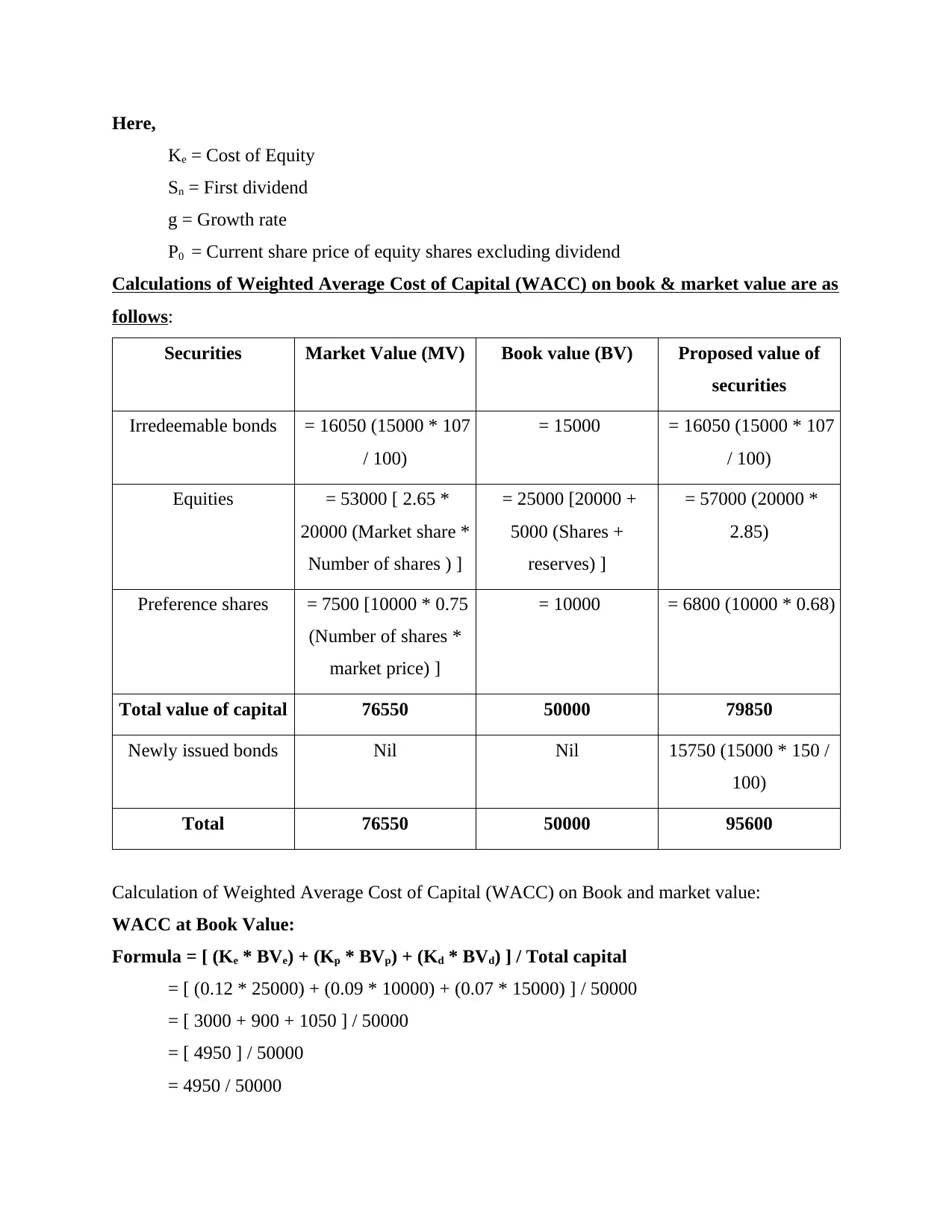
Here,
Ke = Cost of Equity
Sn = First dividend
g = Growth rate
P0 = Current share price of equity shares excluding dividend
Calculations of Weighted Average Cost of Capital (WACC) on book & market value are as
follows:
Securities Market Value (MV) Book value (BV) Proposed value of
securities
Irredeemable bonds = 16050 (15000 * 107
/ 100)
= 15000 = 16050 (15000 * 107
/ 100)
Equities = 53000 [ 2.65 *
20000 (Market share *
Number of shares ) ]
= 25000 [20000 +
5000 (Shares +
reserves) ]
= 57000 (20000 *
2.85)
Preference shares = 7500 [10000 * 0.75
(Number of shares *
market price) ]
= 10000 = 6800 (10000 * 0.68)
Total value of capital 76550 50000 79850
Newly issued bonds Nil Nil 15750 (15000 * 150 /
100)
Total 76550 50000 95600
Calculation of Weighted Average Cost of Capital (WACC) on Book and market value:
WACC at Book Value:
Formula = [ (Ke * BVe) + (Kp * BVp) + (Kd * BVd) ] / Total capital
= [ (0.12 * 25000) + (0.09 * 10000) + (0.07 * 15000) ] / 50000
= [ 3000 + 900 + 1050 ] / 50000
= [ 4950 ] / 50000
= 4950 / 50000
Ke = Cost of Equity
Sn = First dividend
g = Growth rate
P0 = Current share price of equity shares excluding dividend
Calculations of Weighted Average Cost of Capital (WACC) on book & market value are as
follows:
Securities Market Value (MV) Book value (BV) Proposed value of
securities
Irredeemable bonds = 16050 (15000 * 107
/ 100)
= 15000 = 16050 (15000 * 107
/ 100)
Equities = 53000 [ 2.65 *
20000 (Market share *
Number of shares ) ]
= 25000 [20000 +
5000 (Shares +
reserves) ]
= 57000 (20000 *
2.85)
Preference shares = 7500 [10000 * 0.75
(Number of shares *
market price) ]
= 10000 = 6800 (10000 * 0.68)
Total value of capital 76550 50000 79850
Newly issued bonds Nil Nil 15750 (15000 * 150 /
100)
Total 76550 50000 95600
Calculation of Weighted Average Cost of Capital (WACC) on Book and market value:
WACC at Book Value:
Formula = [ (Ke * BVe) + (Kp * BVp) + (Kd * BVd) ] / Total capital
= [ (0.12 * 25000) + (0.09 * 10000) + (0.07 * 15000) ] / 50000
= [ 3000 + 900 + 1050 ] / 50000
= [ 4950 ] / 50000
= 4950 / 50000
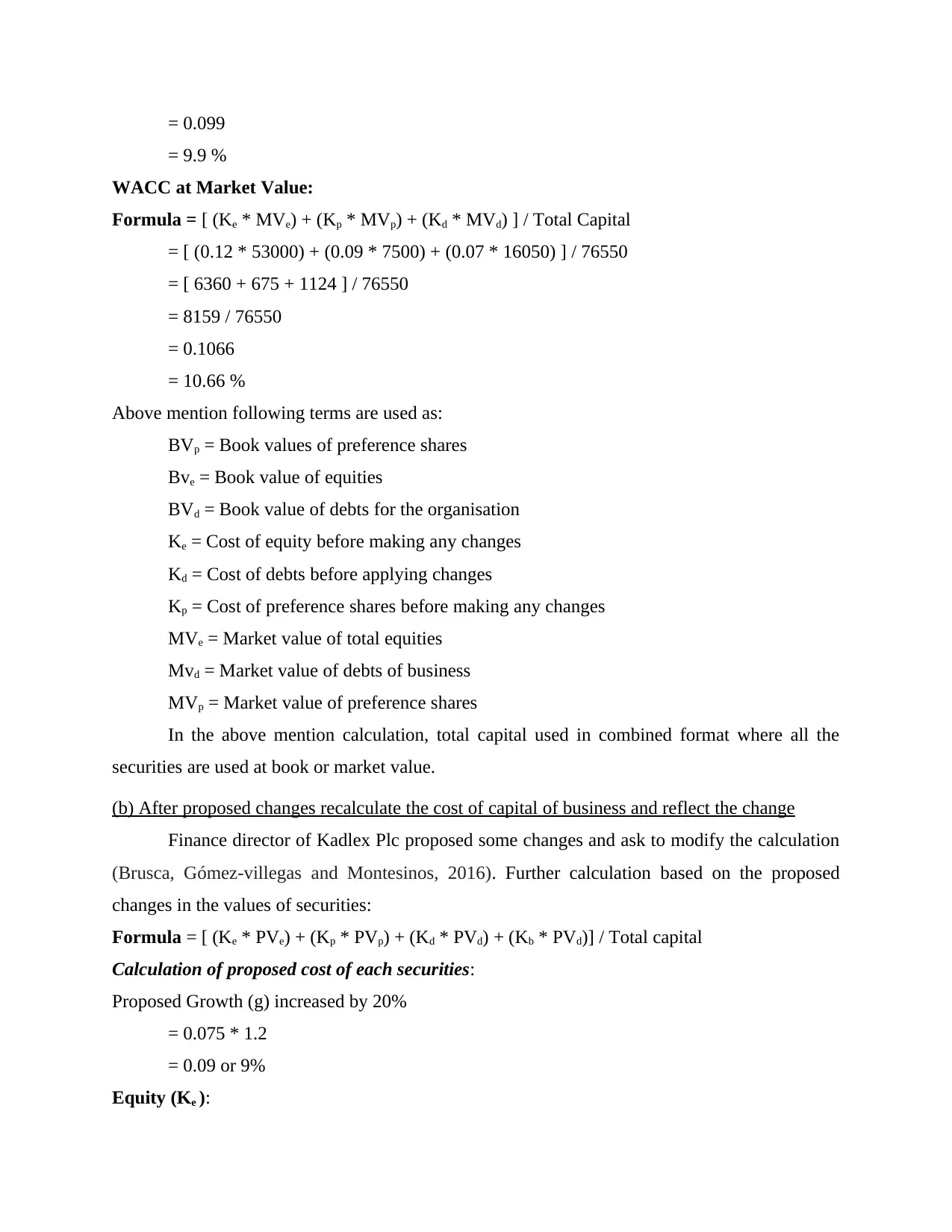
= 0.099
= 9.9 %
WACC at Market Value:
Formula = [ (Ke * MVe) + (Kp * MVp) + (Kd * MVd) ] / Total Capital
= [ (0.12 * 53000) + (0.09 * 7500) + (0.07 * 16050) ] / 76550
= [ 6360 + 675 + 1124 ] / 76550
= 8159 / 76550
= 0.1066
= 10.66 %
Above mention following terms are used as:
BVp = Book values of preference shares
Bve = Book value of equities
BVd = Book value of debts for the organisation
Ke = Cost of equity before making any changes
Kd = Cost of debts before applying changes
Kp = Cost of preference shares before making any changes
MVe = Market value of total equities
Mvd = Market value of debts of business
MVp = Market value of preference shares
In the above mention calculation, total capital used in combined format where all the
securities are used at book or market value.
(b) After proposed changes recalculate the cost of capital of business and reflect the change
Finance director of Kadlex Plc proposed some changes and ask to modify the calculation
(Brusca, Gómez‐villegas and Montesinos, 2016). Further calculation based on the proposed
changes in the values of securities:
Formula = [ (Ke * PVe) + (Kp * PVp) + (Kd * PVd) + (Kb * PVd)] / Total capital
Calculation of proposed cost of each securities:
Proposed Growth (g) increased by 20%
= 0.075 * 1.2
= 0.09 or 9%
Equity (Ke ):
= 9.9 %
WACC at Market Value:
Formula = [ (Ke * MVe) + (Kp * MVp) + (Kd * MVd) ] / Total Capital
= [ (0.12 * 53000) + (0.09 * 7500) + (0.07 * 16050) ] / 76550
= [ 6360 + 675 + 1124 ] / 76550
= 8159 / 76550
= 0.1066
= 10.66 %
Above mention following terms are used as:
BVp = Book values of preference shares
Bve = Book value of equities
BVd = Book value of debts for the organisation
Ke = Cost of equity before making any changes
Kd = Cost of debts before applying changes
Kp = Cost of preference shares before making any changes
MVe = Market value of total equities
Mvd = Market value of debts of business
MVp = Market value of preference shares
In the above mention calculation, total capital used in combined format where all the
securities are used at book or market value.
(b) After proposed changes recalculate the cost of capital of business and reflect the change
Finance director of Kadlex Plc proposed some changes and ask to modify the calculation
(Brusca, Gómez‐villegas and Montesinos, 2016). Further calculation based on the proposed
changes in the values of securities:
Formula = [ (Ke * PVe) + (Kp * PVp) + (Kd * PVd) + (Kb * PVd)] / Total capital
Calculation of proposed cost of each securities:
Proposed Growth (g) increased by 20%
= 0.075 * 1.2
= 0.09 or 9%
Equity (Ke ):
⊘ This is a preview!⊘
Do you want full access?
Subscribe today to unlock all pages.

Trusted by 1+ million students worldwide

(Ke ) = [ {28*(1.09) }+0.09] / 2.85
= 0.1074
= 10.74 %
Preference (Kp ):
(Kp ) = [ (7 / 68)]
= 0.1029
= 10.29 %
Irredeemable Bonds (Kd) :
(Kd) = [10 (1 – 0.30) ] * 100 / 107
= 0.0654
= 6.54 %
New Bonds (Kd):
(Kd) = [0.11 (1-0.30) ] * 100 / 105
= 0.0733
= 7.33 %
Proposed WACC after changes:
= [ (0.11 * 57000) + (0.10 * 6800) + (0.07 * 16050) + (0.07 * 15750) / 95600
= (6270 + 680 + 1124 + 1103) / 95600
= 9177 / 95600
= 0.966
= 9.66 %
(c) Critically discussed the organization by integrating a sensible level of gearing into their
capital structure and minimise (WACC)
From the above calculation it has been critically analysed that WACC has proposed
changes of 9.66% where market value of WACC is 10.66%. It clearly mentioned that company
save up to 1% of cost of capita. It is also analysed that, if proposed structure integrated with
current market value than WACC will be decline by 1% (Burtonshaw-Gunn, 2017).
Organizations can build different management plans for funding such as company can invest in
the new machine or in any other assets which helps in generating more revenue in the future.
= 0.1074
= 10.74 %
Preference (Kp ):
(Kp ) = [ (7 / 68)]
= 0.1029
= 10.29 %
Irredeemable Bonds (Kd) :
(Kd) = [10 (1 – 0.30) ] * 100 / 107
= 0.0654
= 6.54 %
New Bonds (Kd):
(Kd) = [0.11 (1-0.30) ] * 100 / 105
= 0.0733
= 7.33 %
Proposed WACC after changes:
= [ (0.11 * 57000) + (0.10 * 6800) + (0.07 * 16050) + (0.07 * 15750) / 95600
= (6270 + 680 + 1124 + 1103) / 95600
= 9177 / 95600
= 0.966
= 9.66 %
(c) Critically discussed the organization by integrating a sensible level of gearing into their
capital structure and minimise (WACC)
From the above calculation it has been critically analysed that WACC has proposed
changes of 9.66% where market value of WACC is 10.66%. It clearly mentioned that company
save up to 1% of cost of capita. It is also analysed that, if proposed structure integrated with
current market value than WACC will be decline by 1% (Burtonshaw-Gunn, 2017).
Organizations can build different management plans for funding such as company can invest in
the new machine or in any other assets which helps in generating more revenue in the future.
Paraphrase This Document
Need a fresh take? Get an instant paraphrase of this document with our AI Paraphraser

(e) Evaluate the effect of short termism on bankruptcy and find the agency problem in a
company
Organizations pay attention to formulating strategies which help the management to
achieve their goals & objectives or generate higher revenue in the future. Through evaluating
short- termism, business focus on short term outputs which further beneficial to achieve their
long term goals. On the other hand, agency problem is the situation where conflict arises due to
interest build in any relationship. This problem affect the personal growth and the other side,
short termism negativity affect the bankruptcy which generate agency problem. Overuse of
equities will create conflicts among the shareholders because they wanted to earn higher retunes
and which further affect the rate of dividend. Because of short termism, bankruptcy situations
will take place and due to overuse of equity will generate the same situations for the
organizations (Falconier, 2015).
Question 3
(a) Calculate by using following investment appraisal techniques and recommend that how it
economically feasible to acquire new machine
At the time of making any decisions regarding investment company need to analyse that
it is profitable for the business or not. It is possible with the help of investment appraisal
techniques which facilitate the organizations to make decisions regarding investment (Hasibuan
and Syahrial, 2019). Lovewell is food manufacturing company which wanted to invest in a new
machinery in order to maximise the productivity as well as profitability.
Payback Period: It can be defined as a technique which is used by various large entities
in capital budgeting for the purpose of determining the time taken by an investment to repay the
value of it. In other words, it could be considered as a length of time which is taken by a project
to reach the BEP (Break Even Point). While planning to invest in a project it is focused by
organisations as desirability of an investment depends upon its pay back period.
Formula:
Payback Period = Total outflow of funds / inflows
Calculations:
Inflow = 85000
Outflow = 12500
company
Organizations pay attention to formulating strategies which help the management to
achieve their goals & objectives or generate higher revenue in the future. Through evaluating
short- termism, business focus on short term outputs which further beneficial to achieve their
long term goals. On the other hand, agency problem is the situation where conflict arises due to
interest build in any relationship. This problem affect the personal growth and the other side,
short termism negativity affect the bankruptcy which generate agency problem. Overuse of
equities will create conflicts among the shareholders because they wanted to earn higher retunes
and which further affect the rate of dividend. Because of short termism, bankruptcy situations
will take place and due to overuse of equity will generate the same situations for the
organizations (Falconier, 2015).
Question 3
(a) Calculate by using following investment appraisal techniques and recommend that how it
economically feasible to acquire new machine
At the time of making any decisions regarding investment company need to analyse that
it is profitable for the business or not. It is possible with the help of investment appraisal
techniques which facilitate the organizations to make decisions regarding investment (Hasibuan
and Syahrial, 2019). Lovewell is food manufacturing company which wanted to invest in a new
machinery in order to maximise the productivity as well as profitability.
Payback Period: It can be defined as a technique which is used by various large entities
in capital budgeting for the purpose of determining the time taken by an investment to repay the
value of it. In other words, it could be considered as a length of time which is taken by a project
to reach the BEP (Break Even Point). While planning to invest in a project it is focused by
organisations as desirability of an investment depends upon its pay back period.
Formula:
Payback Period = Total outflow of funds / inflows
Calculations:
Inflow = 85000
Outflow = 12500

Total outflow of funds = 275000
Actual inflow = Inflow – outflow
= 85000 – 12500
= 72500
Pay back period = 275000 / 72500
= 3.79 years
Accounting Rate of Return (ARR): This technique is used by business entities to
calculate return which could be generated by an organisation from the net income of future
investment option (Karadag, 2015). It is used by management as it can facilitate the managers to
formulate effective capital budgeting decisions. It ignores the time value of money while
calculations as it is based upon net incomes rather than cash inflows.
Formula:
ARR = = Average profit / Total outflow of funds * 100
Calculations:
Machine Life = 6 years
Total outflow of funds = 275000
Inflow = 85000
Outflow = 12500
Residual value = 15% on machine cost.
Year 1 2 3 4 5 6
Inflows 85,000 85,000 85,000 85,000 85,000 85,000
Less: Outflows 12,500 12,500 12,500 12,500 12,500 12,500
Profit before & after
depreciation (PBAD)
72,500 72,500 72,500 72,500 72,500 72,500
Less: Depreciation 38,958 38,958 38,958 38,958 38,958 38,958
Profit Before
Depreciation
33,542 33,542 33,542 33,542 33,542 33,542
Working Notes:
Average profit = Total profit / 6
Actual inflow = Inflow – outflow
= 85000 – 12500
= 72500
Pay back period = 275000 / 72500
= 3.79 years
Accounting Rate of Return (ARR): This technique is used by business entities to
calculate return which could be generated by an organisation from the net income of future
investment option (Karadag, 2015). It is used by management as it can facilitate the managers to
formulate effective capital budgeting decisions. It ignores the time value of money while
calculations as it is based upon net incomes rather than cash inflows.
Formula:
ARR = = Average profit / Total outflow of funds * 100
Calculations:
Machine Life = 6 years
Total outflow of funds = 275000
Inflow = 85000
Outflow = 12500
Residual value = 15% on machine cost.
Year 1 2 3 4 5 6
Inflows 85,000 85,000 85,000 85,000 85,000 85,000
Less: Outflows 12,500 12,500 12,500 12,500 12,500 12,500
Profit before & after
depreciation (PBAD)
72,500 72,500 72,500 72,500 72,500 72,500
Less: Depreciation 38,958 38,958 38,958 38,958 38,958 38,958
Profit Before
Depreciation
33,542 33,542 33,542 33,542 33,542 33,542
Working Notes:
Average profit = Total profit / 6
⊘ This is a preview!⊘
Do you want full access?
Subscribe today to unlock all pages.

Trusted by 1+ million students worldwide

= (33,542 +33,542 +33,542 +33,542 +33,542 +33,542) / 6
= 33,542
Depreciation = Total outflow of funds – residual value / total life of project
= 2,75,000 – 41,250 / 6
= 38,958
ARR = 33542 / 275000 * 100
= 0.1220 *100
= 12.20 %
Internal Rate of Return (IRR): This method of capital budgeting is used to determine
the rate of return which could be generated by an organisation by making investment in a project.
All the external factors such as financial risks, cost of capital, risk free returns and inflations are
ignored in calculations of this technique because internal rate is calculated in it (Martin, 2016). A
very low IRR shows that the project should be ignored by the company because it will not be
able to provide good returns on the project.
Formula:
IRR = Lower discounted rate + present value of lower discounted rate – total outflows of
funds / present value of higher discounted rate – present value of lower discount rate (higher
discounted rate – lower discounted rate)
Available Information:
Total outflow = 275000
Inflow = 72500 each year
Residual value = 15% of original cost of machine
Total life of machine = 6 years
Assumed information:
Lower discount rate = 14%
Higher discount rate = 18%
With the help of trial and error method IRR calculated and the discounted rates are 14%
and 18%.
Calculation based on Present value factor @ 14%:
Year Inflows
Present value factor
14% Present value
= 33,542
Depreciation = Total outflow of funds – residual value / total life of project
= 2,75,000 – 41,250 / 6
= 38,958
ARR = 33542 / 275000 * 100
= 0.1220 *100
= 12.20 %
Internal Rate of Return (IRR): This method of capital budgeting is used to determine
the rate of return which could be generated by an organisation by making investment in a project.
All the external factors such as financial risks, cost of capital, risk free returns and inflations are
ignored in calculations of this technique because internal rate is calculated in it (Martin, 2016). A
very low IRR shows that the project should be ignored by the company because it will not be
able to provide good returns on the project.
Formula:
IRR = Lower discounted rate + present value of lower discounted rate – total outflows of
funds / present value of higher discounted rate – present value of lower discount rate (higher
discounted rate – lower discounted rate)
Available Information:
Total outflow = 275000
Inflow = 72500 each year
Residual value = 15% of original cost of machine
Total life of machine = 6 years
Assumed information:
Lower discount rate = 14%
Higher discount rate = 18%
With the help of trial and error method IRR calculated and the discounted rates are 14%
and 18%.
Calculation based on Present value factor @ 14%:
Year Inflows
Present value factor
14% Present value
Paraphrase This Document
Need a fresh take? Get an instant paraphrase of this document with our AI Paraphraser
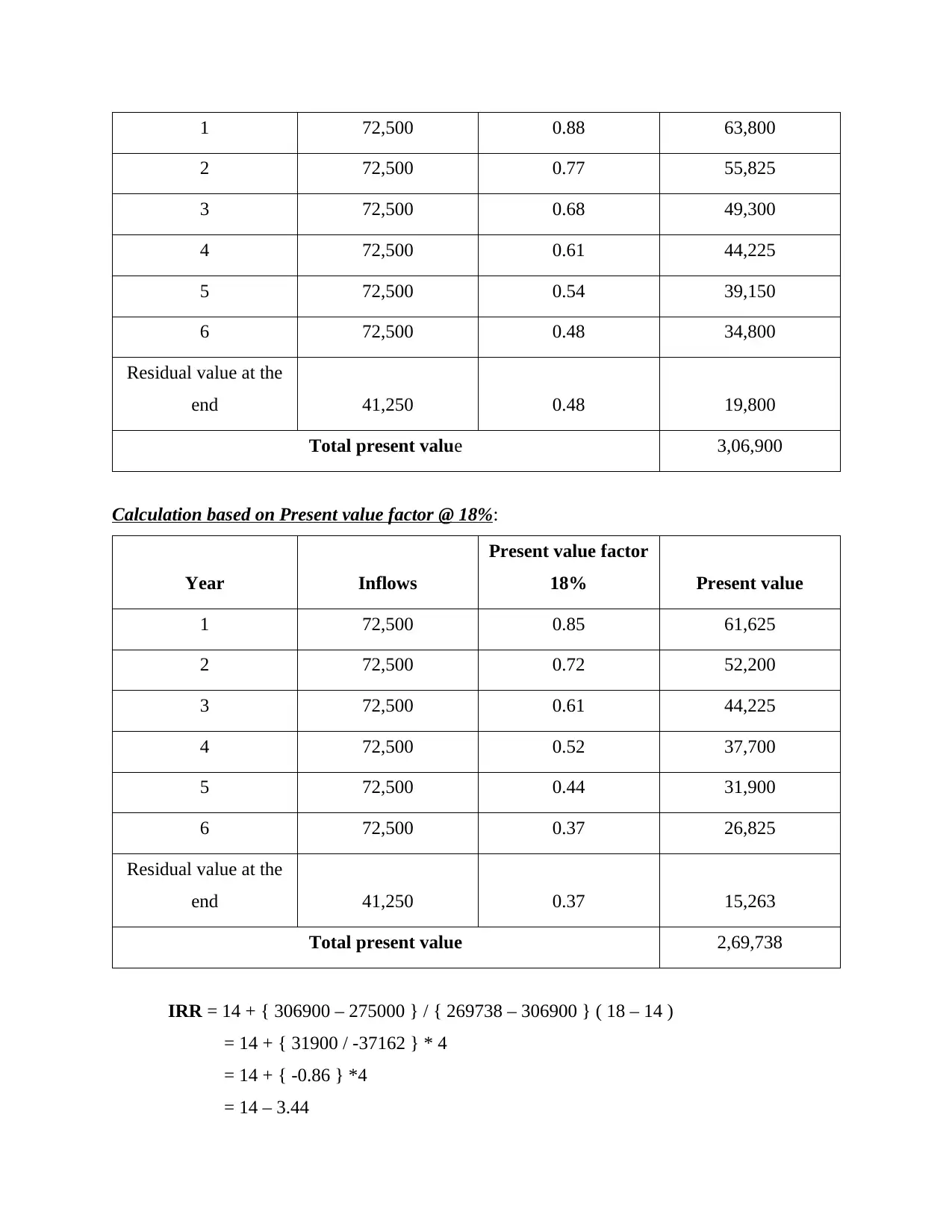
1 72,500 0.88 63,800
2 72,500 0.77 55,825
3 72,500 0.68 49,300
4 72,500 0.61 44,225
5 72,500 0.54 39,150
6 72,500 0.48 34,800
Residual value at the
end 41,250 0.48 19,800
Total present value 3,06,900
Calculation based on Present value factor @ 18%:
Year Inflows
Present value factor
18% Present value
1 72,500 0.85 61,625
2 72,500 0.72 52,200
3 72,500 0.61 44,225
4 72,500 0.52 37,700
5 72,500 0.44 31,900
6 72,500 0.37 26,825
Residual value at the
end 41,250 0.37 15,263
Total present value 2,69,738
IRR = 14 + { 306900 – 275000 } / { 269738 – 306900 } ( 18 – 14 )
= 14 + { 31900 / -37162 } * 4
= 14 + { -0.86 } *4
= 14 – 3.44
2 72,500 0.77 55,825
3 72,500 0.68 49,300
4 72,500 0.61 44,225
5 72,500 0.54 39,150
6 72,500 0.48 34,800
Residual value at the
end 41,250 0.48 19,800
Total present value 3,06,900
Calculation based on Present value factor @ 18%:
Year Inflows
Present value factor
18% Present value
1 72,500 0.85 61,625
2 72,500 0.72 52,200
3 72,500 0.61 44,225
4 72,500 0.52 37,700
5 72,500 0.44 31,900
6 72,500 0.37 26,825
Residual value at the
end 41,250 0.37 15,263
Total present value 2,69,738
IRR = 14 + { 306900 – 275000 } / { 269738 – 306900 } ( 18 – 14 )
= 14 + { 31900 / -37162 } * 4
= 14 + { -0.86 } *4
= 14 – 3.44

= 10.56 %
Net Present Value (NPV): This investment appraisal technique is used by organisations
to evaluate the current value of the project in which they are planning to invest monetary
resources for betterment of business (Matthew, 2017). It totally depends upon discount rate and
take time value of money in to consideration. With the help of it managers of business entities
decide that the project in which they are planning to invest will be profitable for them or not.
Formula:
NPV = Total present value / Total outflow of funds
Available Information:
Total outflow = 2,75,000
Inflow = 72,500 every year
Cost of capital = 12%
Residual value = 15% on original machine cost
Life = 6 years
Calculations for present value at 12% are as follows:
Year Inflows Present value factor
12%
Present value
1 72,500 0.89 64,525
2 72,500 0.80 58,000
3 72,500 0.71 51,475
4 72,500 0.64 46,400
5 72,500 0.57 41,325
6 72,500 0.51 36,975
Residual value at the
end
41,250 0.51 20,138
Total present value 3,18,838
NPV = 3,18,838 – 2,75,000
Net Present Value (NPV): This investment appraisal technique is used by organisations
to evaluate the current value of the project in which they are planning to invest monetary
resources for betterment of business (Matthew, 2017). It totally depends upon discount rate and
take time value of money in to consideration. With the help of it managers of business entities
decide that the project in which they are planning to invest will be profitable for them or not.
Formula:
NPV = Total present value / Total outflow of funds
Available Information:
Total outflow = 2,75,000
Inflow = 72,500 every year
Cost of capital = 12%
Residual value = 15% on original machine cost
Life = 6 years
Calculations for present value at 12% are as follows:
Year Inflows Present value factor
12%
Present value
1 72,500 0.89 64,525
2 72,500 0.80 58,000
3 72,500 0.71 51,475
4 72,500 0.64 46,400
5 72,500 0.57 41,325
6 72,500 0.51 36,975
Residual value at the
end
41,250 0.51 20,138
Total present value 3,18,838
NPV = 3,18,838 – 2,75,000
⊘ This is a preview!⊘
Do you want full access?
Subscribe today to unlock all pages.

Trusted by 1+ million students worldwide
1 out of 16
Related Documents
Your All-in-One AI-Powered Toolkit for Academic Success.
+13062052269
info@desklib.com
Available 24*7 on WhatsApp / Email
![[object Object]](/_next/static/media/star-bottom.7253800d.svg)
Unlock your academic potential
Copyright © 2020–2025 A2Z Services. All Rights Reserved. Developed and managed by ZUCOL.





